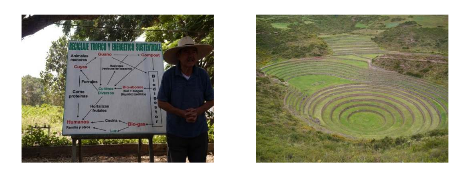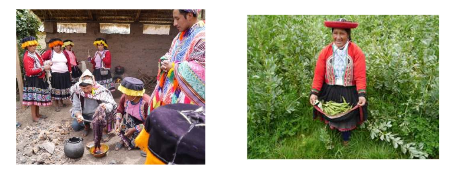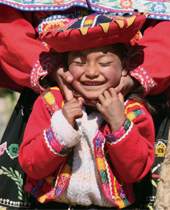I recently returned from a culinary tour of Peru, led by Gail Hall. Gail is a chef, educator, writer and food explorer with plans to go to South India for even more culinary adventures in early 2016.
For me, the common thread running through this diverse journey was the resourcefulness and resilience of Peruvians. The first day, we met Ulises, who left his job as a professor of environmental physiology to create an organic, sustainable farm in the Lurin Valley near Lima. He and his wife, Carmen, have been farming here for 30 years. All plant and animal waste goes to producing compost, other fertilizers, or gas for the outdoor cooktop. Students and volunteers come to learn this way of farming.
Later in the tour, we visited the Moray agricultural terraces in the Andes mountain plateau, near Cusco. These terraces served as a crop laboratory for the Incan people, who ruled the Andes region in the 15th and 16th centuries. Differences in sun, shade, and elevation – and warmer temperatures at the bottom than at the top of the bowl – created optimal conditions for growing different types of plants at 3500 metres altitude. So the study and practice of sustainable agricultural in Peru have a long history! We saw much evidence of Incan ingenuity while in Peru, including the famed lost city of Machu Picchu.

We visited traditional Quechua Andean communities, where residents still do all their work by hand. Our host dyes wool from a lamb that was partially sheared in our presence, as local guide Miguel looks on. The dark red dye comes from cochineal, a parasite that feeds on prickly pears. In the second Quechua community we visited, we helped one of the family members pick fava beans, then made lunch. A new Cusco International Airport is planned for this area. Residents are concerned about how construction, noise and traffic will impact their land, plants, and animals. But they also see employment opportunities for the young, and more tourism. The local school is teaching English.

Gail’s culinary tours always include cooking classes, which use fresh ingredients that reflect the bounty of the region. Peruvians make creative use of all that grows around them. Here we are making a salad with the fresh palm hearts and majambo beans that are abundant in the Amazon region. Majambo is a wild relative of cacao.
The people who live in the tiny Amazonian village of Chazuta personify resilience. Chazuta was once home to the cocaine trade, and plagued by violence. The women of the award-winning Mishki Cacao Co-op began growing cacao in 2000 alongside their husbands, with support from the U.S. government and international aid organizations that were helping farmers grow alternatives to illegal coca. In 2009, the women added value by making chocolate and products from majambo. During our visit, they were generous with their time, songs, and samples. We also spent some time at Ceramica de Chazuta the same day. This was my first try at pottery. I sure appreciated the assistance of experienced potters who offer these workshops to earn a living and to keep their local traditions alive. The potters sell finished products to villagers and tourists.

Arequipa has been called the world’s alpaca capital. Peruvians have for centuries used alpacas for wool, meat, and as pack animals. A few lucky alpacas appear to have a life of leisure at the Mundo Alpaca Museum, alongside their llama relatives. Before we left Arequipa, I found two lovely sweaters in this IntiAlpaca shop run by a co-op of 30 alpaca farming families. When I wear one of my new sweaters, I am reminded of Peruvians’ resourcefulness, their pride in country, and their hospitality in sharing many wonderful culinary and other cultural experiences with our group.

Tammy travelled to Peru in March, 2015. Her tour leader, Gail Hall has more culinary tours coming up with us. Visit the Culinary South India tour page by clicking here.



